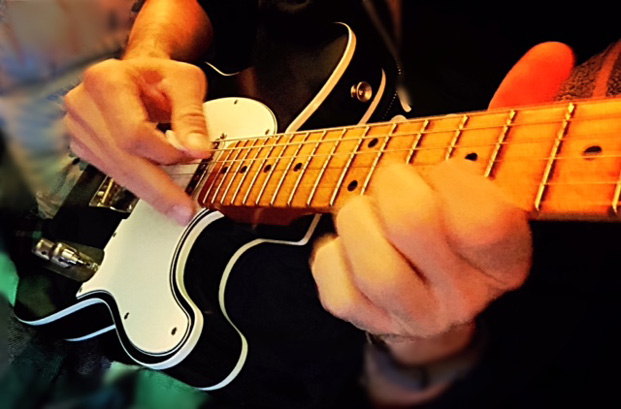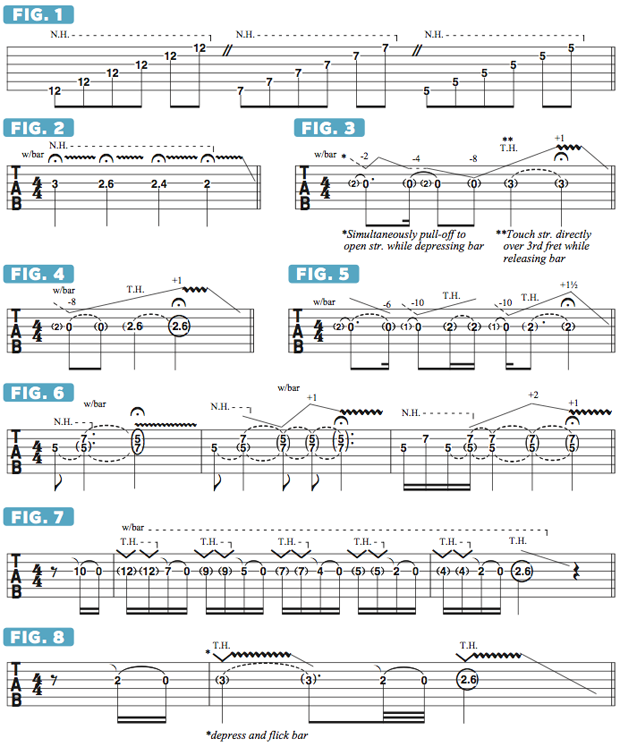A Guide to High-Pitched Natural Harmonics
Learn some licks that utilize natural harmonics.

In this month’s column, I’d like to demonstrate several licks that utilize natural harmonics. A natural harmonic (N.H.) is sounded by picking an open string while lightly touching it with a fret-hand finger directly above a given fret.
The natural harmonics that are easiest to produce and are most commonly used are those found directly above the 12th, seventh and fifth frets. When executed properly, a natural harmonic should have a bell-like chime that rings clearly and sustains. Let’s begin by lightly resting the ring finger across all six strings directly above the 12th fret and picking each string individually, as shown in FIGURE 1.
I then proceed to do the same thing at the seventh and fifth frets. (Remember, the finger must touch the string directly above the fret.) Some of my favorite natural harmonics—the ones I use most often to create cool-sounding licks—are found on the G string between the second and third frets.
As shown in FIGURE 2, I rest my ring finger directly above the third fret to sound a high D natural harmonic and move back slightly to a point just ahead of the midpoint between the second and third frets (indicated as 2.6 in the tab) to sound a high F natural harmonic. I then move back a hair more to just behind the midpoint (indicated as 2.4) to sound a G, four octaves higher than the pitch of the open string. I then play the natural harmonic directly above the second fret, which is a very high A. These higher, “stratospheric” natural harmonics are not as loud as those at the 12th, seventh and fifth frets and are more challenging to sound clearly. You can help bring them out by using your guitar’s bridge pickup and lots of gain.
For each of these harmonics, I use the whammy bar to add vibrato, which also helps the note to sustain a little longer. I can then depress the bar to get the harmonic to quickly drop, or “dive,” in pitch.
A very cool natural-harmonic technique—one that players like Dimebag Darrell, Joe Satriani and Steve Vai have gotten a lot of mileage out of—is to pull off to the open G string while simultaneously dropping the whammy bar, and then lightly touch the string at different points while raising the bar to get a great ascending-harmonic sound. In FIGURE 3, I quickly pull off with the index finger at the second fret of the G string to get the string vibrating, dropping the whammy bar simultaneously, after which I lightly touch the string directly above the third fret to sound the natural harmonic located there. This is often referred to as a “touch harmonic” and is indicated by the abbreviation “T.H.”
In FIGURES 4 and 5, I move slightly behind the third fret (2.6) and to the second fret to sound even higher, screaming natural harmonics.
Another great technique is to play the high G harmonic located above the fifth fret of the G string along with the high F# harmonic located above the seventh fret of the B string, as I do in FIGURE 6. Notice I again use the whammy bar to shake or lower and raise the pitch of the harmonics. In FIGURE 7, I repeatedly pull off to the open G string from different points along the fretboard so I can add natural harmonics at the 12th, ninth, seventh, fifth and fourth frets, as well as just behind the third fret, adding two quick whammy-bar scoops as each harmonic sounds.
Lastly, in FIGURE 8, I use the same technique to get the G string ringing but quickly “flick” the whammy bar to get a fast warble on each harmonic, followed by a whammy-bar dive.

Get The Pick Newsletter
All the latest guitar news, interviews, lessons, reviews, deals and more, direct to your inbox!






![Joe Bonamassa [left] wears a deep blue suit and polka-dotted shirt and plays his green refin Strat; the late Irish blues legend Rory Gallagher [right] screams and inflicts some punishment on his heavily worn number one Stratocaster.](https://cdn.mos.cms.futurecdn.net/cw28h7UBcTVfTLs7p7eiLe.jpg)



